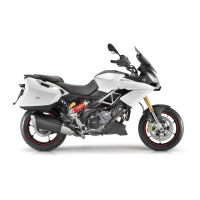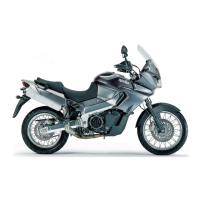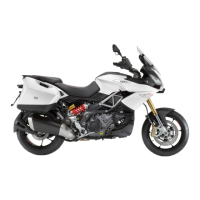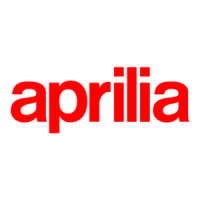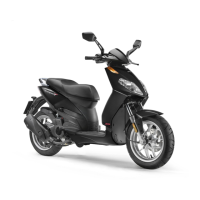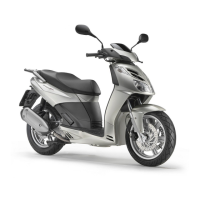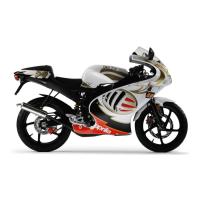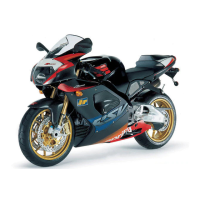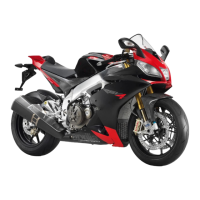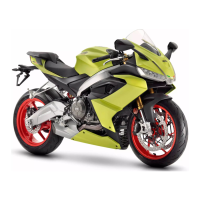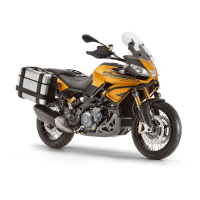
Do you have a question about the APRILIA Caponord 1200 2016 and is the answer not in the manual?
| Engine Type | V-twin |
|---|---|
| Displacement | 1197 cc |
| Fuel System | Electronic fuel injection |
| Transmission | 6-speed |
| ABS | Yes |
| Traction Control | Yes |
| Seat Height | 840 mm (33.1 in) |
| Power | 125 hp |
| Torque | 115 Nm |
| Rear Suspension | Mono shock |
| Front Brakes | Dual 320 mm discs |
| Rear Brakes | Single 240 mm disc |
| Wheelbase | 1, 565 mm (61.6 in) |
| Fuel Capacity | 24 liters |
| Dry Weight | 214 kg |
| Frame | Aluminum alloy |
Essential safety precautions for handling fuel, hot parts, coolant, and battery.
Procedures for disassembling and reassembling components, emphasizing care and proper tool usage.
Critical torque values for various fasteners to ensure vehicle safety and integrity.
Key physical specifications including length, width, height, saddle height, and weight.
Fluid capacities for fuel tank, engine oil, coolant, and maximum weight limits.
List of specialized tools required for servicing, with store codes and descriptions.
A comprehensive table detailing maintenance tasks and intervals based on mileage or time.
Recommended lubricants and fluids from Castrol for vehicle maintenance.
A step-by-step guide to diagnose and resolve issues related to the EFI warning light or abnormal engine behavior.
Guidelines for routing, positioning, and securing electrical cable harnesses and components.
Information on entering, modifying, and storing immobiliser codes and key management.
Details on battery specifications, charging, voltage checks, and error codes related to the battery.
Details on throttle body function, operation, parameters, and error codes related to throttle position.
Steps required before removing the engine, including disconnecting components and removing auxiliary parts.
Detailed instructions and images for safely removing the engine from the motorcycle chassis.
Exploded view, torque specifications, and removal procedure for the gear selector mechanism.
Components and torque specifications for the ignition system, including spark plugs and rotor.
Exploded view and torque specifications for water pump components on the clutch side.
Procedures for disassembling and checking cylinder, piston, and piston rings for wear and clearance.
Instructions for removing the fuel pump and fuel level probe from the tank.
Exploded views, torque specifications, and procedures for disassembling and reassembling front fork components.
Torque values and procedures for adjusting steering headstock and fork legs.
Exploded views and removal/revision procedures for the rear suspension shock absorbers.
Components, torque specifications, and removal/checking procedures for the front wheel and its bearings.
Components, torque specifications, and removal procedures for the rear wheel and its associated parts.
Procedures for removing, inspecting, installing, and adjusting the drive chain.
Procedures for removing the tail pipe, catalytic converter, and exhaust manifold, including options.
Overview of the ABS system, including ECU pin configuration and diagnostic information.
Procedures for bleeding the braking system, including regular bleeding and post-ABS unit replacement.
Step-by-step guide for replacing brake fluid, including vehicle preparation and purging process.
Procedure for bleeding the clutch hydraulic system to remove air.
Steps for removing the left handguard, mirror, clutch lever, cable, and master cylinder.
Step-by-step instructions for draining and replacing the coolant, including cautions.
Exploded view, torque specifications, and removal procedure for the water pump components.
Procedures for removing and installing windshield components, including fasteners and torque values.
Procedures for removing and installing fuel tank components, including level sensor and fasteners.
Procedures for removing and installing the instrument panel and its support structure.
Procedures for removing and installing the headlight assembly and associated dashboard components.
Checklist for inspecting paintwork, plastic parts, scratches, and dirt before delivery.
Inspection of critical fasteners including suspension, brake, wheel, engine, and steering components.
Checks for main switch, lights, indicators, instrument panel, horn, and starter operation.
Verification of fluid levels for hydraulic braking, clutch, gearbox, transmission, engine coolant, and engine oil.
